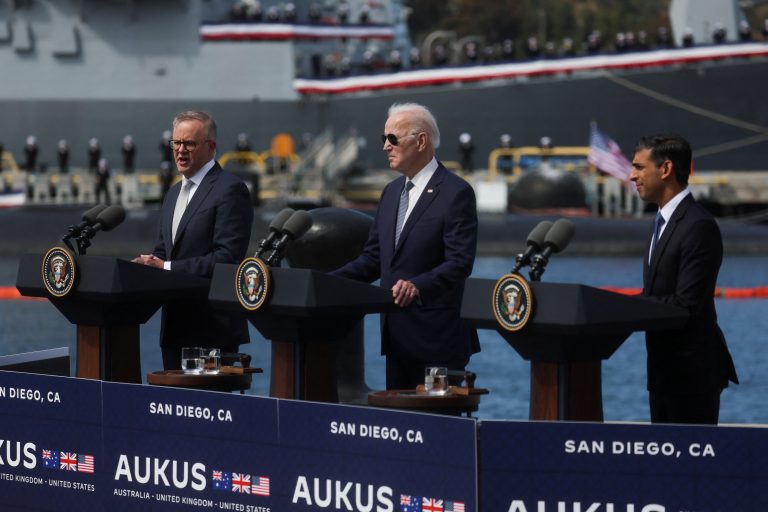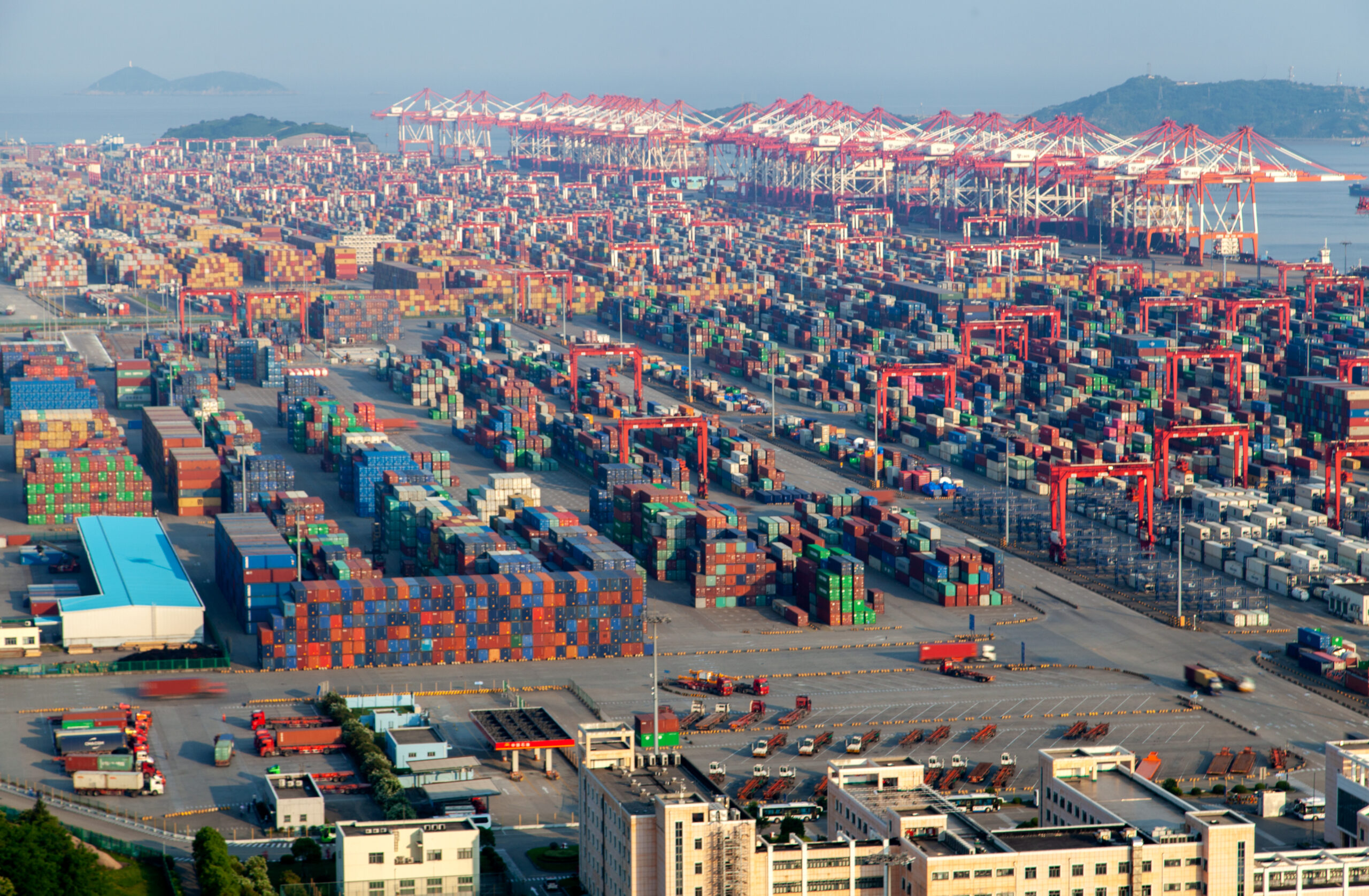[동아시아포럼] 오커스 동맹, 동남아시아와의 국방기술 협력 모색
2021년, 미국·호주·영국 안보 파트너십 ‘오커스’ 동맹 출범 인도·태평양 지역 핵잠수함 배치, 핵심 국방기술 협력 골자 말레이시아, 인도네시아 등 동남아 국가, 군사적 긴장 우려
[동아시아포럼]은 EAST ASIA FORUM에서 전하는 동아시아 정책 동향을 담았습니다. EAST ASIA FORUM은 오스트레일리아 국립대학교(Australia National University) 크로퍼드 공공정책대학(Crawford School of Public Policy) 산하의 공공정책과 관련된 정치, 경제, 비즈니스, 법률, 안보, 국제관계에 대한 연구·분석 플랫폼입니다. 저희 폴리시코리아(The Policy Korea)와 영어 원문 공개 조건으로 콘텐츠 제휴가 진행 중입니다.
지난 2021년 9월 미국, 영국, 호주 3개국은 인도·태평양 지역에서의 외교·안보 협력 파트너십인 오커스(AUKUS) 동맹을 출범했다. 3개국 간의 협정은 두 개의 필러(Pillar)로 구성돼 있는데 이 중 필러1은 호주의 핵잠수함 보유를 위한 3국 간의 협력을 말한다. 호주는 필러1을 통해 핵잠수함을 보유할 수 있는 기회를 확보했고 이는 향후 호주의 국방전략에 큰 변화를 가져올 것으로 예상된다. 필러2는 인공지능(AI), 초음속 미사일, 심해역량, 사이버전자전 등 분야에서의 최첨단 기술 협력으로 호주는 오커스 동맹을 통해 확보한 기술을 활용해 동남아시아와의 국방 협력을 강화할 것으로 기대하고 있다.

오커스 3국, 호주에 핵잠수함 조기 공급 계획 밝혀
오커스 동맹에서 언급된 기술 모두 중요하지만 특히 핵잠수함의 확보는 큰 주목을 받았다. 지난 3월 조 바이든 미국 대통령, 리시 수낵 영국 총리, 앤서니 앨버니지 호주 총리는 미국 샌디에이고 로마(Loma) 해군기지에서 오커스 정상회담를 열고 미국의 버지니아급 핵잠수함 최대 5척을 당초 계획보다 10년 앞당긴 2030년대 초까지 호주에 인도하겠다고 밝혔다. 이 계획이 완료되면 호주는 세계 7번째의 핵잠수함 보유국이 된다.
하지만 오커스 동맹이 핵잠수함을 호주에 인도하기로 결정하는 과정에서 호주와 인근 동남아시아 국가 간의 긴장관계가 조성됐다. 동남아시아 국가들은 오커스 동맹과 핵잠수함 배치가 인도·태평양 지역에서 강대국 간의 군비 경쟁을 촉발하고 군사적 긴장을 증폭시킬 것이란 우려를 제기했다. 일부 동남아시아 국가의 국방 관계자들도 호주의 핵잠수함이 해당 지역의 안보에 긍정적으로 작용할지, 아니면 주변국의 주권을 위협하는 요인이 될지 불확실하다는 점을 비공식 석상에서 언급하기도 했다. 특히 호주가 보유하게 될 핵잠수함은 탁월한 원양작전 능력을 갖추고 있어 바닷속에서 매우 조용하고 은밀하게 잠행할 수 있는 강점을 지닌 점도 주변국의 우려를 낳았다.
동남아시아 국가들은 오커스 동맹 초기 회의적인 입장을 나타냈지만 시간이 지나면서 인근 국가들은 오커스 동맹의 방향성과 기능에 대해 수용하기 시작했다. 최근에는 일부 동남아시아 국가들이 오커스와의 협력을 강화함으로써 자국의 이득을 확대하고자 하는 사례가 나타나면서 호주와 동남아시아 국가 간의 전략적 이해관계가 접점을 찾아가고 있다.
동남아시아, 사이버전자전 등 핵심기술 이전 희망
안보 전문가들은 호주와 동남아시아 국가의 관계에서 필러2가 중요한 역할을 할 수 있을 것으로 보고 있다. 호주 정부도 국제사회의 관심이 오커스 핵잠수함으로 상징되는 필러1에 쏠리는 것과는 달리 필러2의 중요성을 강조하고 있다. 실제로 핵잠수함을 배치하는 필러1에 수십 년이 소요되는 반면 최첨단 기술을 개발·공유하는 필러2는 비교적 이른 시기에 성과를 거둘 수 있다. 앞서 지난 4월 발표한 ‘2023년 호주 국방전략보고서’에도 필러2의 실행을 전담할 고위 관료나 장교를 배치하는 방안을 담았다. 같은 달 오커스 동맹 3개국은 영국에서 필러2의 AI를 적용해 목표물을 탐지하고 추적하는 기술을 시연하기로 했다.
각국 국방 관계자들에 따르면 일부 동남아시아 국가들은 필러2의 기술 중 심해역량과 사이버전자전 분야에서의 협력을 희망하고 있다. 이들은 호주가 최첨단의 군사기술을 전부 이전하지는 못하더라도 최소한의 방어 역량을 확보하기 위한 기술적 지원을 기대하고 있다. 특히 사이버전자전은 중국과의 관계 등을 고려할 때 동남아시아 국가들이 가장 필요로 하는 기술이다. 보안업체 레코디드 퓨처의 보고서에 따르면, 중국 정부가 후원하는 단체들이 말레이시아, 필리핀, 태국, 베트남, 인도네시아 등 동남아시아 국가들의 국방부와 정당 등 주요 기관을 대상으로 사이버 스파이 활동을 수행하고 있는 것으로 전해졌다.
호주-인도네시아, 해저 인프라 모니터링 협력 가능
인도네시아는 해저 역량에 대한 협력을 희망하고 있다. 섬나라인 인도네시아는 호주와 아시아를 잇는 해저 케이블을 보유하고 있으며 해당 케이블은 싱가포르에서 호주 퍼스까지 4,600km에 이르는 초고용량 광섬유 시스템인 ‘호주-싱가포르 케이블(ASC)’을 포함하고 있다. 호주는 적대국이 ASC를 공격할 가능성에 대해 우려하고 있지만 인도네시아는 ASC와 같은 해저 인프라를 모니터링하고 관리한 기술을 보유하고 있지 않은 상황이다. 이런 가운데 필러2는 호주가 인도네시아에 해저 인프라에 대한 모니터링 기술을 이전하는 데 도움이 될 것으로 보인다.
하지만 오커스 협정에 따르면 동맹국 외에 다른 국가들과 필러2의 기술을 공유하거나 이전하는 것을 제한할 수 있다. 이 때문에 호주가 동남아시아 국가들과 기술 협력을 확대하기 위해서는 필러2 기술의 이전이나 공유가 동남아시아 국가의 국방 역량을 제고함으로써 자국은 물론 동맹국의 안보에 기여할 수 있다는 점을 동맹국에게 설득해야 한다. 지리적으로 호주와 인접한 동남아시아 국가는 호주의 안전과 번영에 있어 중요한 역할을 한다. 따라서 호주 정부가 필러2의 기술 협력을 영리하게 활용한다면 국방·외교 분야에서 전략적 목표를 달성할 수 있을 것이다. 나아가 동남아시아 국가들과의 협력을 통해 국가들간의 우호적 관계를 강화할 수 있다면 핵잠수함 배치에 대한 주변국들의 부정적 정서를 해소하는 데도 기여할 수 있을 것으로 전망된다.
AUKUS brings more than nuclear submarines to Southeast Asia
The AUKUS agreement between the United States, the United Kingdom and Australia significantly shifts Australia’s defence strategy and future capabilities by providing the opportunity for Australia to acquire nuclear-powered submarines. But Australia will also receive advanced technologies under Pillar Two of the deal. This is one area in which Australia can leverage AUKUS to cement its defence relations with Southeast Asia.

Pillar Two focusses on developing advanced technologies in several areas, including artificial intelligence (AI), hypersonic missiles, undersea capabilities, cyberspace and electronic warfare.
Many of these technologies are just as crucial to Australia as the nuclear submarines, but it’s the acquisition of nuclear-powered submarines has received most of the public’s attention. The AUKUS leaders’ joint statement in March 2023 was issued at Naval Base Point Loma in San Diego, California with warships in the background. Even the joint statement by the three leaders focussed mainly on submarine-related issues.
Perhaps the focus on nuclear submarines is unavoidable. But the Albanese government and a number of security specialists have recognised the broader importance of Pillar Two. The Australian government’s 2023 Defence Strategic Review demonstrates this by calling for a senior official or officer to be appointed to focus on the implementation of this part of AUKUS.
The emphasis given to acquiring nuclear-powered submarines under AUKUS has caused friction between Australia and several Southeast Asian states, drawing concerns that AUKUS could trigger an arms race and ratchet up military tensions in Asia.
Underlining these concerns is the uncertainty expressed privately by several Southeast Asian defence officials as to whether nuclear-powered submarines will be a net contributor to Southeast Asian security or a source of instability that threatens their sovereignty. One key concern is that Australian nuclear-powered submarines may end up operating covertly within Southeast Asian states’ territorial waters.
Despite the initial scepticism, Southeast Asian officials have quietly accepted that AUKUS is here to stay, and some are looking at drawing benefits from its existence. This creates a convergence point between Australian and regional strategic interests.
This is where Pillar Two could play a part. Unlike the first pillar, which will take decades to come to fruition, the second is comparatively low-hanging fruit that can be developed rapidly. This was shown in the deployment of AI-enabled assets to detect and track military targets during a demonstration in the United Kingdom in April 2023.
Based on interviews and conversations with Southeast Asian defence officials, some regional states are interested in receiving assistance in undersea capabilities, cyberspace and electronic warfare — areas well within the scope of AUKUS’ Pillar Two.
These defence officials privately expressed their understanding that Australia will not be open to sharing the most advanced military technologies acquired. But they hope for assistance in developing minimum defensive capabilities, especially in the cyber and maritime domains.
The cyber domain represents one of the most promising for Pillar Two in Southeast Asia. Based on a Recorded Future report, Chinese state-sponsored entities are known to conduct espionage activities targeting critical institutions in Southeast Asia, including defence-related organisations in Malaysia, the Philippines and Thailand, and political offices in Vietnam and Indonesia.
Another area in which Australia could collaborate with Southeast Asian states, especially Indonesia, is in undersea capabilities. Indonesia is an archipelago connecting Australia with Asia through critical undersea cables traversing its waters. This includes the Australia–Singapore Cable (ASC), Australia’s most advanced, high-capacity and low-latency submarine fibre optic cable system stretching some 4600 kilometres from Singapore to Perth.
Indonesia does not have the capabilities to monitor and secure undersea infrastructure, such as the ASC, even though several officials privately expressed their suspicions that submarines from a certain foreign power have been secretly operating within the Indonesian archipelago. This situation indirectly threatens Australia, as hostile powers could target the ASC and other undersea cables and critical infrastructure. Thankfully, Pillar Two provides a mechanism through which Australia could assist Indonesia in developing its undersea monitoring capabilities.
But one key feature of the AUKUS agreement may limit Australia’s sharing of Pillar Two technologies with Southeast Asian states. Advanced technologies under AUKUS are developed trilaterally with the United Kingdom and the United States. They may not want to transfer or share advanced technologies with parties outside the AUKUS framework. Australia must convince its AUKUS partners that certain Pillar Two technologies can be shared safely with selected Southeast Asian states to improve their defence capabilities and indirectly contribute to Australia’s security.
Given its geographical proximity, Southeast Asia is crucial to Australia’s security and prosperity. Skilfully leveraging Pillar Two will enable Australia to attain strategic objectives in both defence and foreign affairs. Southeast Asian states would likely perceive Australia’s efforts to improve their defence capabilities as improving rather than destabilising their security environment, making Pillar One all the easier to accept.
원문의 저자는 호주 로위연구재단(Lowy Institute)의 동남아시아 프로그램 연구원 압둘 라만 야콥(Abdul Rahman Yaacob)입니다.



























